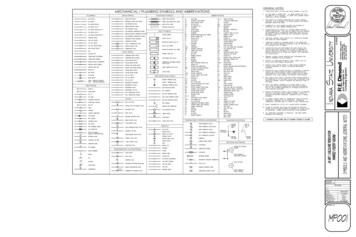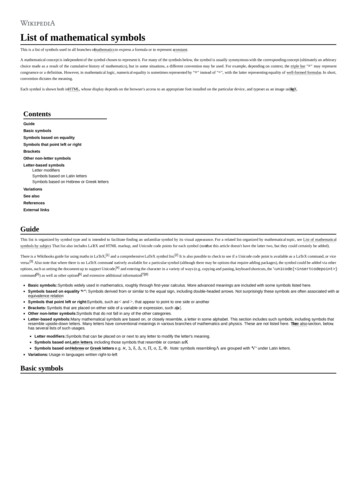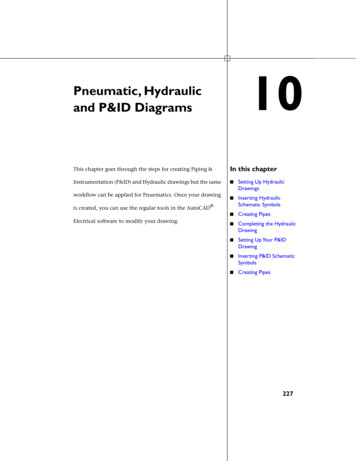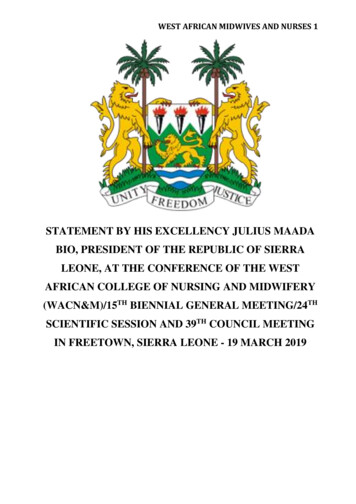
Transcription
Partnering for a Healthy WorldWest African Wisdom: Adinkra Symbols & Meaningswww.welltempered.net/adinkra/htmls/adinkra index.htmAfrican symbols known as adinkra are ubiquitous in Ghana, a beautiful West African country onthe Atlantic Ocean, situated between Cote d’Ivoire and Togo. On cloth and walls, in potteryand logos, these Asante tribe symbols can be found everywhere.These icons are used to represent the four different sections and additional facts in this report:BEST IN SCIENCEHWE MU DUA“MEASURING STICK”symbol of examination and quality controlThis symbol stresses the need to strive for the best quality, whether inproduction of goods or in human endeavors.READINESS AND RESPONSEPEMPAMSIE “SEW IN READINESS“symbol of readiness, steadfastness, hardinessAccording to The Adinkra Dictionary, the design of this symbol resemblesthe links of a chain, and implies strength through unity as well as theimportance of being prepared.PARTNERSHIPSBOA ME NA ME MMOA WO “HELP ME AND LET ME HELP YOU“symbol of cooperation and interdependenceThis symbol emphasizes the idea that aid is reciprocal. In order to be goodteachers we must be great students who appreciate the art of cooperationand support.ABOUT CDCADINKRAHENE “CHIEF OF THE ADINKRA SYMBOLS”symbol of greatness, charisma, and leadershipThis symbol signifies the importance of playing a leadership role.DID YOU KNOW?NYANSAPO “WISDOM KNOT”symbol of wisdom, ingenuity, intelligence, and patienceThis symbol conveys the idea that a wise person has the capacity to choosethe best means to attain a goal.
Research chemists, Brian Basden, B.S., and Amal Wanigatunga, B.S., inspect a solid-phase-extraction cartridge priorto analysis for environmental chemicals.PAGE 1Welcome to CDCPAGE 2Health Protection GoalsPAGE 3BEST IN SCIENCEControlling the Obesity EpidemicDiabetes Tracking and Prevention Shows ProgressNew HIV Test Revises Epidemic TrendsMore Immigrants Being Screened for TuberculosisPandemic Influenza: New Test, New VaccinesInnovations in Medicine SafetyPreventing Disability from Disfiguring LymphedemaIncreasing Vaccine Access to Children WorldwideAccessing Family History for Disease Risk and PreventionKeeping Water Safe for the Navajo NationPAGE 16READINESS AND RESPONSECDC Responds in 2008Containing Worldwide ThreatsCDC and FBI Share Investigative TechniquesPandemic Influenza PreparednessCDC East turns to CDC West after EarthquakePAGE 22PARTNERSHIPSPartnering to Curb Teen Dating Violence“Amazing” HIV Support GroupReductions in Healthcare-associated InfectionsWork Continues in Kenya Despite Post-election ViolenceOne Millionth Call to 1-800-QUIT-NOWStaying Healthy at the Olympics2008 Physical Activity GuidelinesPAGE 30ABOUT CDCWorkforceWork SitesOperating ComponentsFiscal Year 2008 SnapshotGo Green, Get HealthyCommunity ConnectionsCDC FoundationPAGE 39Challenges in 2009PAGE 40CDC Mission and Contact Information
Welcome to CDCWelcome to The State of CDC, Fiscal Year 2008, our annual health protection impact report.Each day at CDC, we try to imagine a safer, healthier world: a world where infants are born healthy and cared for,so as children, they can arrive at school safe, well-nourished, and ready to learn; a world in which teenagers have theinformation, motivation, and hope they need to make healthy choices about their lifestyles and behaviors; and a worldin which adults enjoy active and productive lives in safe communities where they can remain independent and engagedwith family and friends throughout their senior years.“Partnering for a Healthy World” is the theme of this year’s State of CDC report.Imagining this safer, healthier world brings us closer to reaching our vision of “Healthy People in a Healthy World—Through Prevention.”For over 60 years, CDC’s mission has been dedicated to protecting health and promoting quality of life through theprevention and control of disease, injury, and disability. We are committed to programs that reduce the health andeconomic consequences of the leading causes of death and disability, and programs that ensure a long, productive, andhealthy life for all people.CDC is our nation’s leading health protection agency.We take our role very seriously, as CDC protects the health of Americans on many levels and in many arenas. Weconduct surveillance on a wide range of health threats—from infectious diseases to bioterrorism to environmental hazards.When diseases break out around the globe, CDC responds at a moment’s notice, lending its expertise and resources toconduct outbreak investigations and provide technical assistance.We also provide funding for state and local health departments, community based organizations, and academicinstitutions for a wide array of public health programs and research. Each day, Americans benefit from those activitiesthrough the safety and health tips we promote directly to the public, the training and education we offer our partners,and the guidance and recommendations we provide for health care providers.So much has changed in the world since the CDC was founded in 1946. We have had to find new ways to carry out ourmission and meet new threats head-on, whether a terrorist attack or the next global epidemic of an infectious disease likeSARS or avian flu. As we look forward to the next 60 years and beyond, we will continue to position ourselves as thenation’s health protection leader.To learn more about CDC, visit us on the web at www.cdc.gov.
Health Protection GoalsCDC is committed to achieving true improvements in people’s lives by accelerating the impact of positive healthpractices and reducing health disparities. A set of four overarching Health Protection Goals has been created and aresupported by a number of CDC strategic goals and objectives. For more information, visitwww.cdc.gov/osi/goals/goals.html.Healthy People in Every Stage of LifeHealthy People in Healthy PlacesAll people, and especiallyThe places where peoplethose at greater risk of healthlive, work, learn, and playdisparities, will achieve theirwill protect and promote theiroptimal lifespan with the besthealth and safety, especiallypossible quality of health inthose people at greater risk ofevery stage of life.health disparities.People Prepared for Emerging Health ThreatsHealthy People in a Healthy WorldPeople in all communities willPeople around the worldbe protected from infectious,will live safer, healthier, andoccupational, environmental,longer lives through healthand terrorist threats.promotion, health protection,and health diplomacy.Strategic Imperatives1. Health Impact Focus. Align CDC’s staff, strategies, goals, investments, and performance tomaximize impact on the population’s health and safety.2. Customer-centricity. Market what people want and need to choose health.3. Public Health Research. Create and disseminate the knowledge and innovations people need toprotect their health now and in the future.4. Leadership. Leverage CDC’s unique expertise, partnerships, and networks to improve the healthsystem.5. Globalization. Extend CDC’s knowledge and tools to promote health protection around the world.6. Accountability. Sustain people’s trust and confidence by making the most efficient and effectiveuse of their investment in CDC.
BEST IN SCIENCEToday we face a broad range of urgent threats, from emerginginfections and climate change to increased health care costs andan aging population. Meeting each of these challenges requiresa strong grounding in scientific evidence. CDC is guided by thisprinciple to create tools, systems, and networks that advance publichealth practices and improve the nation’s health status. Our scientificfindings and recommendations are much more than data andstatistics—our staff and partners use this information to guide publichealth actions that improve and protect lives around the world.CDC’s commitment to protecting health is reinforced and guidedby a set of four overarching Health Protection Goals that focuson better health for all people by accelerating health impact andachieving health equity. In these stories you will read how the strategicimperatives have been applied to meet the health protection goals.In this section, you will read about how CDC and its partners areworking to control the obesity epidemic, increase vaccine access tochildren worldwide, and keep water safe for the Navajo Nation.These stories represent only a fraction of the work being done byCDC and its partners. We hope they inspire you to learn more aboutCDC, its people and partners, and the science behind our publichealth activities.Stories in this Section Controlling the Obesity Epidemic Diabetes Tracking and Prevention Shows Progress New HIV Test Revises Epidemic Trends More Immigrants Being Screened for Tuberculosis Pandemic Influenza: New Test, New Vaccines Innovations in Medicine Safety Preventing Disability from Disfiguring Lymphedema Increasing Vaccine Access to Children Worldwide Accessing Family History for Disease Risk and Prevention Keeping Water Safe for the Navajo NationEpidemiologist Thai-An Nguyen, M.P.H., isplating (growing) a mixed bacteria culturefor further microbiologic characterization.BEST IN SCIENCE
Controlling the Obesity EpidemicCDC partnerships, innovative interventions, and new research findings in 2008 all contributed to the early signs ofsuccess in the prevention and control of obesity on both the state and national levels. From classrooms to living rooms,recent evidence indicates that obesity rates have hit a plateau—a critical first step in reversing the alarming trends thathave been increasing since 1980.For example, CDC surveys found no increase in obesity prevalence among women or men between 2003–2004 and2005–2006. Evidence from the Youth Risk Behavior Surveillance System indicates that the prevalence of high body massindex (BMI) among children and adolescents has leveled off. CDC’s efforts have also helped to increase recognitionof obesity as a national public health problem. From 2000–2006, the number of articles on obesity published in thenational press increased from 2,000 to 6,000. Other important indicators include the substantial shifts in availableschool foods as documented by the 2006 School Policies and Programs Survey, and the large number of US communitiesmobilizing to address obesity prevention and control.CDC is making inroads in the fight against obesity on numerous fronts:Creating Innovative Partnerships. The Healthy Eating Active Living Convergence Partnership seeks to change policies andenvironments to better achieve the vision of Healthy People Living in Healthy Places. Its innovation lies in its focus onengaging people in fields not traditionally involved in public health. This partnership is currently focusing on two areas—transportation and food systems—as powerful leverage points to develop active living environments and improve accessto healthy foods. In 2009, CDC will co-convene a Transportation and Public Health meeting and will co-sponsor a FoodSystems and Public Health meeting. Partners include the California Endowment, Kaiser Permanente, Nemours, RobertWood Johnson Foundation, W.K. Kellogg Foundation, PolicyLink, and Prevention Institute.Convening National Leadership Activities. CDC is leading the development of the National Roadmap for ObesityPrevention and Control plan, expected in 2010. Two conferences that convened in 2008 were stepping stones fordeveloping the Roadmap: The National Summit on Legal Preparedness for Obesity Prevention and Control, whichfocused on law-based strategies for obesity prevention and control; and The Community Approaches to AddressObesity Conference, which focused on understanding, reporting and disseminating successful community-level obesityinterventions. These conferences laid the groundwork for the upcoming Weight of the Nation Conference, scheduled forsummer 2009, which will highlight progress in obesity prevention and control and identify action needed to reverse theepidemic.Advancing National Collaboration on Childhood Obesity Research (NCCOR). Initiated in 2008, NCCOR is helpingto stem the epidemic by advancing coordination across research funding organizations. NCCOR benefits research,evaluation, translation, and dissemination efforts by accelerating the pace of research; reducing redundancy; ensuringfocused initiatives in the areas of greatest need; and building capacity for multilevel, integrated research. NCCOR isdeveloping a shared research agenda focused on priority areas for collaboration. To build momentum and achieve earlyimpact, NCCOR is identifying initial projects while the long-term joint research agenda is being developed. Partnersinclude the National Institutes of Health and the Robert Wood Johnson Foundation.STATE OF CDC 2008: Partnering for a Healthy World4
Developing the Measures Project. There is an absence of agreed-upon measures to assess the policy and environmentalchange strategies that communities are initiating in response to the obesity epidemic. The Measures Project is designatedby CDC as state-of-the-art in community practice because it adds to the existing evidence base while simultaneouslyproviding a tool for communities to focus their obesity efforts. Twenty-six promising policy and environmental changestrategies, each with a single measure, have been identified. A web-based tool that local governments can use to assessperformance on the 26 measures is being pilot tested by 20 communities. These communities will provide feedback onthe feasibility and usefulness of the measures for local governments and policy makers at an end-users meeting in January2009, after which it is expected that the measures will be disseminated and implemented nationwide.Implementing Early Assessment of Programs and Policies to Prevent Childhood Obesity. This two-yearcollaboration identifies a set of local-level programs and policies to improve children’s eating habits and physical activitylevels and determines which have been implemented with apparent success and which merit rigorous evaluation.This assessment prevents premature investment in evaluating programs and policies that have not been implementedadequately, allowing resources to be targeted to those evaluations most likely to fill important gaps in the evidence basefor obesity prevention. Priority is placed on programs and policies implemented in community settings targeting childrenaged 3–17 years and addressing populations that disproportionately experience childhood obesity (e.g., low income;ethnic groups). Fourteen programs and policies have been deemed ready for immediate, full-scale evaluation, of whichone (New York City Daycare Regulations) will undergo rigorous evaluation in late 2009.Translating Research into Practice.CDC translates research findings for use by practitioners, communities, and the public: Lean for Life Web site. A synthesis of the science and practice-based evidence on worksite obesityinterventions, this Web site guides companies in planning, building, promoting, and evaluatingcustomized obesity prevention and control programs. Developed in direct response to organizationsrequesting help in addressing obesity, the Web site includes an obesity cost calculator that projects thecost of obesity for a company and their expected financial return from implementing a program. Swift Worksite Assessment and Translation. This evaluation method allows for rapid assessment ofworksite health promotion programs that help employees attain or maintain a healthy body weight. Themethod generates data sufficient to identify promising and innovative worksite strategies for reducingadult obesity. New translation documents for this method include an implementation guide and site visitprotocol documents; they are available on CDC’s Healthy Worksite Initiative Web site. The Weight Management Research to Practice Series. This series of documents summarizes thescience on various weight management topics and highlights the implications of research findingsfor public health and medical care professionals. Some installments in the series have a companionbrochure geared toward the general public. Five documents are completed covering the topics of fruitsand vegetables, portion sizes, sugar-sweetened beverages, breastfeeding, and low-energy dense foods. Healthy Weight Web site. Launched in 2008, the Healthy Weight Web site was created using CDC’strusted weight management science as the foundation. The Web site emphasizes that healthy weightloss is not just about a “diet” or “program” and provides consumers with credible information, relevantsteps, and tools to help them achieve and maintain a healthy weight for a lifetime.These activities promote CDC’s Health Protection Goals of Healthy People at Every Stage of Life and HealthyPeople in a Healthy World. For more information about these translation efforts, go to CDC’s obesity Web site atwww.cdc.gov/nccdphp/dnpa/obesity/index.htm and click on “selected resources.”DID YOU KNOW?Obesity RatesObesity rates for adults have doubled between 1980 and 2004, while obesity rates for children havenearly tripled. Sixteen percent of US children and more than a third of US adults—more than 72 millionpeople—are obese. Increases in obesity have occurred among the entire population. However, thelargest increases have occurred among children and minorities.BEST IN SCIENCE
Diabetes Tracking and Prevention Shows ProgressCDC’s diabetes prevention and research activities made new strides in 2008. For the first time, estimates of diabetesrates became available at the county level for all of the United States. In response to these new estimates, state-basedprevention programs are identifying and referring more prediabetic Americans into group-based lifestyle programs.CDC is the only federal agency that develops national surveillance systems for diabetes incidence data. Previously, datawere only available at the state level. In July 2008, estimates of diabetes rates became available in each county. Thesedata are an important step toward addressing the burden of diabetes. Nationally, the data indicate increased diabetesrates in areas of the Southeast and Appalachia that have traditionally been recognized as being at higher risk for manychronic diseases, including cancer, heart disease, and stroke.Recent clinical trials have established that moderate weight loss through exercise and healthy eating can reduce the riskfor diabetes by nearly 60% for the estimated 57 million Americans with prediabetes. Interventions may be cost effectiveif the annual per-person cost can be reduced to 100– 200 and if the programs can maintain the quality standardsestablished in the clinical trials. A CDC-funded primary prevention pilot in Minnesota recently documented an annualcost of 160 per participant for lifestyle interventions delivered in group settings. The estimated 5%–7% weight loss inthese participants was consistent with results achieved in clinical trials and supports and sustains CDC’s Health ProtectionGoal of Healthy People in a Healthy World.State-based diabetes prevention and control programs, under the auspices of CDC’s Diabetes Primary Prevention Initiative(DPPI), are demonstrating success in identifying individuals with prediabetes and referring them to lifestyle programsin group settings such as those at the YMCA. DPPI is achieving these results in populations that largely comprise themedically underserved. These efforts provide the foundation for translating primary prevention science into widespreadand broad-based community practice.Diabetes SnapshotDID YOU KNOW?Diabetes is the seventh leading cause of death and the leading cause of adult blindness, kidney failure,and non-traumatic lower extremity amputation. Heart disease deaths are 2–4 times higher for adultswith diabetes.In the last 15 years, the number of people in the United States with diabetes has more than doubled,reaching nearly 24 million Americans.In addition to diabetes, 57 million US adults have prediabetes—elevated blood glucose levels not yethigh enough to be classified as diabetes. Prediabetes increases the chances of developing diabetes10- to 15-fold.The total cost of diabetes in the United States in 2007 was 174 billion, or 20% of total US health carecosts.STATE OF CDC 2008: Partnering for a Healthy World6
2005 County Level Estimates of Diagnosed Diabetes in the United States2005 PERCENT OF ADULTSPercentageof Adults 20 YEARS OLDDIABETES WITH20 YearsOld with DiabetesNATURAL BREAKS0 - 6.56.6 - 8.08.1 - 9.49. 5 - 11.111.2 - 15.0The prevalence of diagnosed diabetes by county was estimated using data from CDC's Behavioral Risk FactorSurveillance System (BRFSS) and data from the US Census Bureau’s Population Estimates Program. Three years ofdata are used to improve the precision of the year-specific county-level estimates of diagnosed diabetes estimates.For example, 2004, 2005, and 2006 were used for the 2005 estimate. CDC is currently working on the county-levelestimates for 2006.Map provided by the Centers for Disease Control and Prevention: National Diabetes Surveillance System. This map and additional information can befound online at www.cdc.gov/diabetes/statistics/index.htm. Retrieved 12/15/2008.BEST IN SCIENCE
New HIV Test Revises Epidemic TrendsMicrobiologist Xin Liu, Ph.D., is training laboratory personnel to perform the new test (BED Incidence Assay) during a workshop in Africa.Accurately tracking the HIV epidemic is essential to the nation’s HIV prevention efforts. Monitoring trends in new HIVinfections has posed a major challenge, since the beginning of the epidemic, in part because many HIV infections are notdiagnosed until years after they occur.CDC has developed a new technology called serologic testing algorithm for recent HIV seroconversion (STARHS).CDC has applied this technology to develop the first national surveillance system of its kind that is based on directmeasurement of new HIV infections. This system provides more precise estimates of HIV incidence (the annual numberof new infections) than ever before, because it can more accurately distinguish recent from long-standing HIV infections.Since CDC applied this advanced technology, the first estimates issued in August2008 indicated that approximately 56,300 new HIV infections occurred in theUnited States in 2006. This figure is roughly 40% higher than CDC’s formerestimate of 40,000 infections per year, which was based on limited data andless precise methods. A CDC historical trend analysis, also published in 2008,suggests that the number of new infections was likely never as low as theprevious estimate of 40,000 and has been roughly stable overall since the late1990s. The new estimate does not represent an actual increase in the number ofnew infections, but rather reflects the ability to more precisely measure new HIVinfections. Accurate measurement of new HIV infections assists CDC’s efforts ineducating people about emerging health threats.The results also confirm that the impact of HIV remains greatest among gay andbisexual men of all races, as well as among African American men and women.In 2006, infection rates among African Americans were seven times as high asCaucasians and almost three times as high as Hispanics, a group that was alsodisproportionately affected.This innovative laboratory test will help CDC track the estimated number of newHIV infections in the United States annually. Information gathered from boththe surveillance system and the test will allow CDC to better monitor the currentcourse of the epidemic, target prevention efforts where they are needed, andassess the impact of current prevention efforts.STATE OF CDC 2008: Partnering for a Healthy World8
More Immigrants Being Screened for TuberculosisEver wonder if CDC has the authority to prevent infectious diseases from entering the United States? It does. In fact,CDC has recently rewritten the rules on how countries should screen and treat people with tuberculosis before theyarrive in this country. This will result in states saving an estimated 2 million in 2009 alone.Medical screening for tuberculosis is legally required before applicants for US immigration (both immigrants and refugees)can receive a visa and enter the United States. Because of CDC’s authority, CDC is working on programs to decreaseillness and death among immigrants and refugees and to prevent diseases from entering the United States. These effortsinclude building a Domestic Refugee Health Program, implementing the Electronic Disease Notification (EDN) system,publishing revised tuberculosis technical instructions, and developing a Refugee Health Initiative.The Domestic Refugee Health Program assists refugees with the health aspects of resettlement and providesrecommendations to physicians for post-arrival health assessments and preventive health interventions. This program alsoworks with health departments to better understand the health problems that refugees face after arrival. The long-termgoal of the Domestic Refugee Health Program is the standardization of medical services for refugees.A long-term initiative now reaching maturity is EDN, an electronic, secure web-based system for notifying healthdepartments of the arrival of immigrants and refugees. This system ensures that refugees receive a prompt post-arrivalmedical evaluation. As of October 1, 2008, the more cost-efficient EDN replaced the nationwide, slower, hard-copynotification system that depended on the mail service. All 50 states are receiving notifications through EDN.In addition, CDC modernized the tuberculosis technical instructions used to screen overseas applicants for USimmigration in 2007. The revised instructions identify additional tuberculosis cases by incorporating modern diagnostictesting and addressing appropriate treatment prior to arrival in the United States. By the end of Fiscal Year 2008, 28% ofUS-bound immigrants were screened for tuberculosis.Implementing the revised instructions is anticipated to result in three timesas many cases of tuberculosis being detected overseas and treated prior toarrival in the United States, allowing for diagnosis and treatment to occurprior to foreign-born persons entering the country. The decreased burden ofdiagnosis and treatment in the United States will lead to an estimated annualcost savings that will reach into the tens of millions, providing leadership inthe global effort to control tuberculosis. This work supports CDC’s HealthProtection Goal of People Prepared for Emerging Health Threats.Additional information about the 2007 tuberculosis technical instructions anda listing of populations being screened can be found online atwww.cdc.gov/ncidod/dq/panel 2007.htm.BEST IN SCIENCE
Pandemic Influenza: New Test, New VaccinesMicrobiologist Catherine Smith, M.M.S.C., illustrates how the new diagnostic device called the “M-Chip” detects highly pathogenic avianH5N1 influenza virus and many other commonly circulating seasonal influenza viruses. The M-Chip was developed in collaboration withScientists at the University of Colorado, Boulder.On September 30, 2008, the US Food and Drug Administration cleared an important new test that can rapidly detectand identify human influenza viruses, including those that may pose a pandemic risk. The human influenza virus realtime polymerase chain reaction detection and characterization panel (RT-PCR) was developed by CDC in collaborationwith Applied Biosystems of Foster City, California and the Association of Public Health Laboratories. Using a molecularbiology technique, the RT-PCR can test multiple samples at once and renders results within just four hours.CDC developed six H5N1 pandemic influenza vaccine candidates derived from viruses from Indonesia and China foruse in manufacturing prepandemic vaccines including H5N1 vaccine candidate Clade 2.1 and H5N1 vaccine candidateClade 2.2. H5N1 viruses are the avian influenza viruses currently causing human cases in Asia and Africa (more than300 cases so far). They are a concern because of the potential to become a new pandemic strain. They have causedoutbreaks in birds (usually chickens) in Asia, Africa, the Middle East, and Europe.CDC also developed a five-target polymerase chain reaction panel for influenza (A, B, H1, H3, and H5); approval ispending from the US Food and Drug Administration. This new area of diagnostics for CDC will greatly enhance diseasedetection, prepare people for emerging health threats, and provide a path for future development.First Pandemic Influenza Ethics Workshop Held in AfricaDID YOU KNOW?CDC collaborated with the African Field Epidemiology Network to convene a symposium on publichealth codes of ethics for pandemic influenza detection and control in Africa. Representatives from15 African countries discussed how to make ethical decisions using current scientific knowledge whileevaluating the effectiveness of interventions.Conference participants identified and discussed African-specific ethical challenges likely to arise duringa pandemic: Enforcement of culling sick poultry when poultry is the primary protein inAfrican diets. Compensation for owners who are required to cull their smaller flocks. Politicians who try to reserve available vaccines for their own use. Opposition to preparing for a pandemic when most people die from AIDS, malaria,and tuberculosis.STATE OF CDC 2008: Partnering for a Healthy World10
Innovations in Medicine SafetyMedicines are used to heal, but they can sometimescause harm when not used correctly. A recent CDCstudy has shown that adverse drug events causemore than 700,000 emergency department visitseach year.CDC partners with other federal agencies to measure,understand, and prevent harm from medicines,especially for the most vulnerable Americans—children and older adults. CDC, with the US Foodand Drug Administration (FDA), joined togetherwith the US Consumer Product Safety
African symbols known as adinkra are ubiquitous in Ghana, a beautiful West African country on the Atlantic Ocean, situated between Cote d’Ivoire and Togo. On cloth and walls, in pottery . CDC partnerships, innovative interventions, and new research findings in 2008










